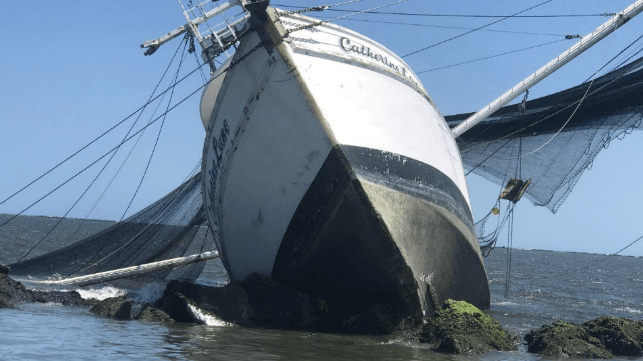NTSB: Faulty Autopilot, Empty Wheelhouse Led to Grounding off Georgia

A captain’s decision to turn on a recently-repaired autopilot and then leave the wheelhouse led to the grounding and sinking of a fishing vessel off Cumberland Island, Georgia, according to the NTSB.
On June 7, two days before the casualty, the captain of the shrimp trawler Sage Catherine Lane found that he couldn't turn off the autopilot, and he had to unplug it to get back manual control. He tried to troubleshoot the issue and found that the rudder angle sensor was bent, loose on its mounting, and reading about 4-5 degrees off the actual rudder angle. He straightened the bent arm of the sensor, put the unit back in the right place and zip-tied it to its mounting. After speaking with the vessel's manager, he determined that this was an appropriate repair and that there was no need to have a technician work on it. The system functioned properly during operations on June 8.
On June 9, 2021, the vessel was transiting outbound on the St. Marys River, making nine knots. The captain - who had 30 years of experience in commercial fishing - set the vessel’s autopilot, then answered a phone call and went below to his stateroom. Shortly after, the vessel turned sharply about 90 degrees to port, towards the north jetty of the entrance channel. The captain returned to the wheelhouse, and he turned to avoid the jetty and put the engine in reverse, but it was too late: the Sage Catherine Lane ran aground on the rocks of the jetty.
The captain tried to back down and pull the boat off the jetty, but without success. The two other crewmembers checked the engine room and found flooding. With the circumstances worsening on board, the three-person crew abandoned ship and were rescued by a Good Samaritan vessel. The wooden-hulled fishing boat broke apart and sank three days later.
The Sage Catherine Lane went down with about 2,300 gallons of fuel, engine oil and hydraulic oil on board. One crewmember sustained a minor injury to his right hand, and the vessel was declared a total loss, at a cost of about $1 million.
The Sage Catherine Lane's sudden and sharp turn to port suggests that the autopilot could have responded to an inaccurate signal from the rudder angle sensor, according to the NTSB. The agency concluded that the autopilot "failed," and that the captain did not have enough time to respond because he had left the wheelhouse.
“Autopilot use does not relieve the operator of responsibility to conduct a proper navigation watch. Use of autopilot should not be a justification for an operator to leave the wheelhouse or bridge unattended in confined waters,” NTSB concluded. “Navigating in channels and harbors requires quicker reaction times due to traffic, currents encountered, and frequent course changes, and more rudder due to slower speeds."
Unattended wheelhouses are a frequent factor in casualties aboard small commercial fishing vessels, which operate with long hours, limited manning, high demand for on-deck manpower, and limited watchstander training.
